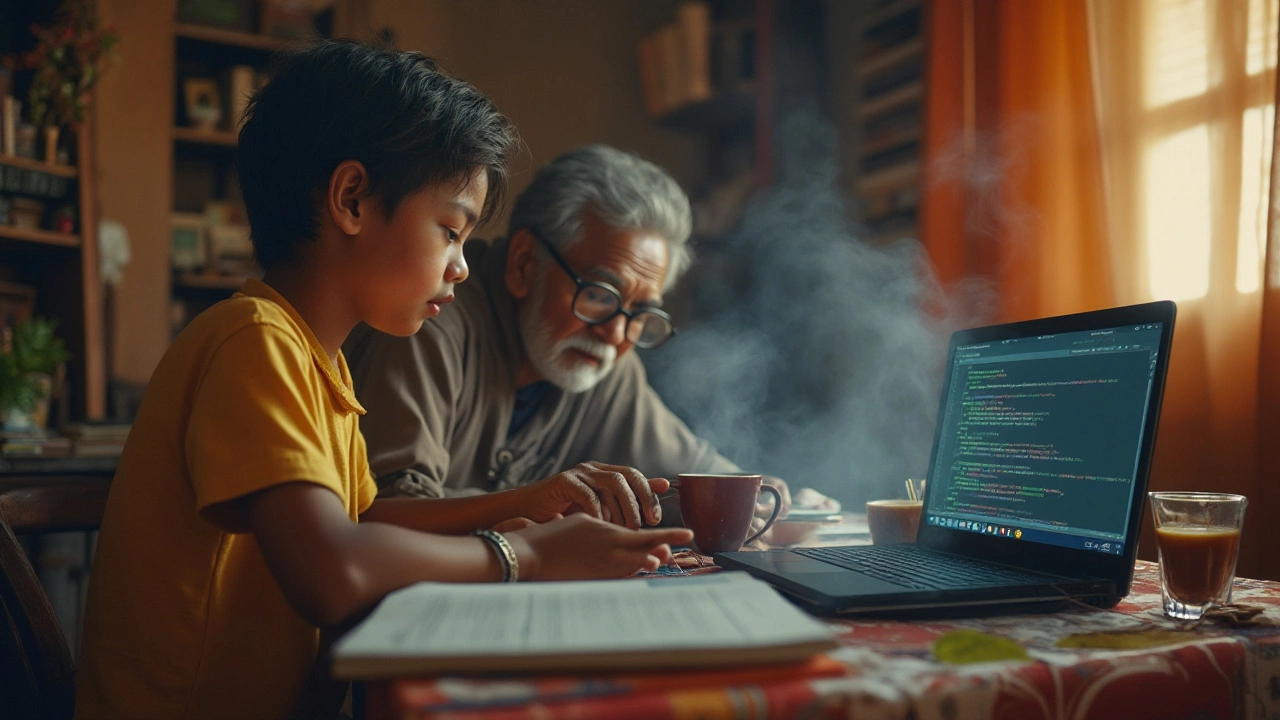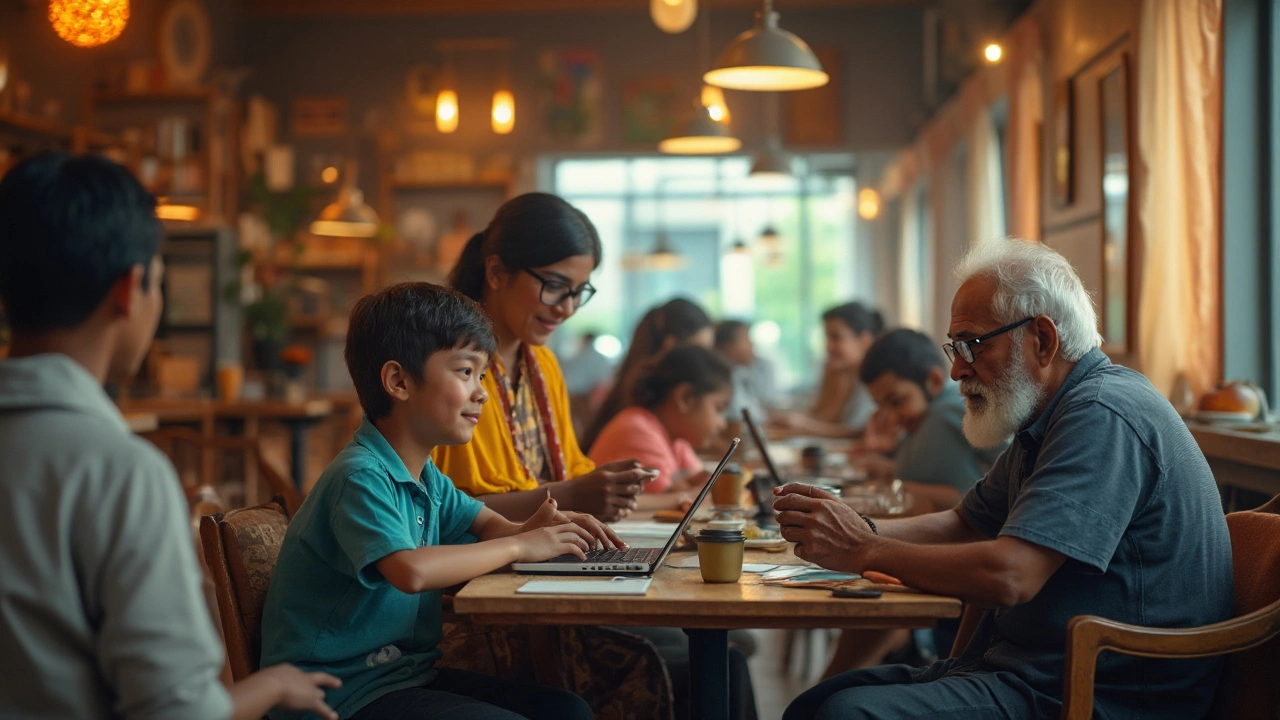The curious question of how old the average coder is often bubbles up in discussions about tech culture and careers. As technology seeps into almost every aspect of our lives, coding has attracted people of all ages. It's no longer just the domain of young tech enthusiasts or university graduates; today, coding is a skill being picked up by a wide array of age groups.
Children as young as eight or nine years old are dabbling in Scratch, while many in their teens are developing their own apps. On the other end of the spectrum, there's a growing number of older adults who are diving into coding as a second or even third career. This speaks to the inclusive nature of coding—it's a skill that truly anyone can learn. What makes coding particularly fascinating is how different age groups bring unique perspectives and experiences to the table, enriching the field even more.
- The Youthful Coders
- Mid-Career Coders
- Coding in Later Life
- Age Diversity in Coding Classes
- Tips for All Ages to Learn Coding
The Youthful Coders
In the bustling realm of technology, coding age is shifting as more young people are drawn into the digital world, making notable strides. This demographic, often characterized as digital natives, finds themselves at ease with technology from an early age. The blossoming interest in coding among youngsters is evidenced by the rising enrollment in coding boot camps and after-school programs. These initiatives offer children not just coding classes but pivotal skills shaping how they see the world—problem-solving, analytical thinking, and creativity being at the forefront.
The push towards engaging younger audiences in coding has been met with immense enthusiasm. For instance, platforms like Code.org have been instrumental in opening up the world of programming to kids as young as six years old. Their mission to allow every student to learn computer science not only equips young minds with vital skills but also opens doors to future opportunities. The idea here is simple: start 'em young. This not only nurtures their curiosity but transforms it into a robust technical acumen.
"Learning to write programs stretches your mind and helps you think better, creates a way of thinking about things that I think is helpful in all domains." – Bill Gates
It's fascinating to see how the landscape of coding education has evolved. Today, many middle and high schools are offering coding as part of their curriculum. Some schools even host hackathons aimed specifically at students, allowing them a platform to solve real-world problems through coding. This kind of targeted exposure is invaluable, as it not only sharpens their skills but provides a sense of purpose and achievement. It's noteworthy that these young coders, undeterred by age, are developing innovative solutions and applications that sometimes rival industry standards. Such energetic spirit and intellectual curiosity are vital contributors to the coding demographics.
Delving deeper, research indicates that through coding, children are not just learning a language but are also learning how to articulate ideas and collaborate effectively. These are skills that transcend the coding discipline, having wide-reaching benefits across various areas of life and education. Coder demographics are becoming more youthful by the day, and this breathes fresh innovation into the tech industry. For these youthful coders, programs like Python and JavaScript are not just tools—they’re canvases for ideas waiting to be brought to life. As these kids move through school and into higher education, the foundations laid by early coding experience ensure they step confidently into a future that promises to be tech-driven.
Mid-Career Coders
Entering or excelling in the world of programming during middle age presents a unique scenario. Here, we explore how professionals who have spent a significant part of their careers in other fields are now embracing the coding revolution. For many, turning to code is not just a pursuit of new knowledge but often a pivot to a whole new career. The tech landscape is replete with stories of individuals who swapped their mid-career roles for something in the tech sector. This change is motivated by various factors, including the promise of higher salaries, flexible working conditions, or simply a long-held passion for technology.
Interestingly, those in their mid-thirties and forties bring with them a depth of experience from their previous jobs, which is invaluable in tech roles. For instance, someone transitioning from a project management background into coding can leverage their management skills to oversee software development projects more efficiently. This crossover of skills not only enriches the individual's coding career but benefits the teams they work with by providing a broader perspective. As these mid-career coders navigate their new path, they blend their life experiences with fresh technical skills, which sometimes makes them more competitive candidates than their younger counterparts.
In a 2022 report by Stack Overflow, it was noted that nearly 20% of developers have more than ten years of professional coding experience, suggesting a significant portion started in their mid-career. This stat underscores an important trend for companies seeking to diversify their tech workforces while tapping into the varied expertise levels of mid-career professionals. Coder demographics are rich with individuals who started their programming journey later, proving that learning new skills isn't bound by age.
Challenges and Benefits of Mid-Career Transition to Coding
While it might seem daunting to embark on a new career path after settling into a particular niche, the benefits can be substantial. One primary challenge faced by mid-career coders is the learning curve associated with mastering new technologies and languages. However, many find that their matured problem-solving skills and ability to grasp complex systems aid significantly. The shift also allows them to update their career trajectory, adapting to workplaces that often prioritize innovation and tech-forward approaches.
"The diversity of thought brought into a tech team by those with varied career paths creates a richer, more inventive culture," said a noted tech educator, highlighting the broader advantages that mid-career coders introduce to the ecosystem.As more educational platforms and bootcamps tailor their offerings to support adult learners or mid-career switchers, the transition becomes less intimidating. The robust and rapidly evolving world of coding classes now caters specifically to this group, ensuring they have the support and structure needed to succeed.

Coding in Later Life
As technology advances rapidly, coding has emerged as a powerful skill that is no longer restricted by age. In today's digital era, a growing number of individuals in their fifties and sixties are embracing programming languages, challenging the stereotype that coding is the reserve of the young. Whether it’s to fulfill a lifelong curiosity, supplement retirement income, or keep mental faculties sharp, learning to code later in life is both feasible and rewarding. This shift reflects a broader trend of lifelong learning, which advocates for continuous education throughout one’s life span.
Interestingly, older adults often bring unique life experiences and problem-solving skills to coding, giving them a distinct advantage. With decades of experience in various industries, they have a broad understanding of projects’ practical applications that allows for innovative solutions. Unlike younger coders fresh out of college, many late bloomers approach coding with patience and persistence, stemming from acquired life skills. These attributes not only benefit their learning journey but also contribute significantly to teams that thrive on diversity.
The belief that cognitive decline is an inevitable part of aging is being debunked, and many people over the age of 50 are demonstrating a remarkable knack for learning new skills, including coding. According to a study published in the journal Nature Communications, engaging in mentally stimulating activities like programming significantly aids in cognitive preservation. There's an increasing body of evidence suggesting that the mental rigors of coding – logic puzzles, pattern recognition, and problem solving – are excellent exercises for maintaining brain health and combating age-related mental decay.
"Just as exercising keeps our bodies strong, learning new skills like coding can keep our minds sharp," says Dr. Jessica Matthews, an expert in adult cognitive therapy. "The act of coding – whether it’s debugging a tricky program or breaking down a complex algorithm – engages various cognitive processes that are crucial for mental endurance."
For those stepping onto this path, numerous resources can make the journey smoother. Many coding classes are now tailored for older adults, with slower pacing and additional support to ease the learning process. Online platforms like Coursera and edX offer courses that can be completed at one's pace, meaning learners can delve into complex topics when they're ready. These platforms often have community forums where learners can connect, discuss challenges, and share triumphs.
Moreover, coding boot camps and workshops specifically designed for later life learners are gaining popularity. They offer a hands-on approach, combining instruction with projects that allow students to apply what they've learned in an encouraging environment. With patience and the right learning strategy, age holds no barriers in the colorful world of coding. It's never too late to start, and perhaps in coding, as in life, the best things truly do come with maturity.
Age Diversity in Coding Classes
Coding classes have become a melting pot of experiences, backgrounds, and ages, providing unique learning environments unrivaled by many other educational fields. As more people recognize the importance of technological literacy, it's fascinating to see how coding classes mirror the diverse tapestry of our society. Traditionally thought of as a young person's skill, coding instruction now attracts a wonderfully mixed crowd. From teenagers eager to harness new computer languages as tools of creativity to professionals in their forties or fifties seeking career changes, coding classes have become spaces where age boundaries blur in the pursuit of knowledge.
The statistics tell an engaging story. According to a 2023 report from Codecademy, a popular online learning platform, the average age of new coding learners is broadening. While the most significant demographic still lies within the 18-24 age bracket, nearly 15% of the platform's new users are aged 35 and over. This indicates a shift in perception about who can and should be learning to code. In addition, more coding bootcamps are observing increased enrollment from individuals aged 50 and over, challenging the notion that technology is only a young person's game.
Coding isn't just a skill. It's a language that knows no age, and everyone is capable of fluently speaking it, regardless of when they start learning," said Zach Sims, founder of Codecademy.
The appeal of coding across age groups can be attributed to various factors. For younger learners, coding is an empowering skill that opens pathways to innovation and futuristic career opportunities. It provides them with tools to transform ideas into tangible applications, feeding both creativity and technical acumen. On the flip side, adults often find coding appealing due to the flexibility and career advancement opportunities it offers. Many professionals see coding as a way to enhance their existing careers or pivot to entirely new fields, providing job security in an increasingly digital world. Importantly, older learners often bring rich life experiences which infuse their coding projects with depth and real-world relevance. As coding education becomes more tailored to adults and varied learning styles, we see how age diversity enriches the learning experience for everyone involved.
Coding classes that embrace age diversity often witness a richer exchange of ideas. Mentoring relationships develop organically, with younger coders offering fresh perspectives and older ones sharing wisdom from past careers and experiences. This dynamic engages all students, making the learning environment not just about absorbing information, but about leveraging diverse backgrounds for creative problem-solving. Many classes feature collaboration-focused workshops where intergenerational teams tackle projects together, fostering teamwork and mutual learning.
To successfully foster an environment where age diversity is celebrated, coding educators are encouraged to ensure their content is relevant and relatable to all age groups. Strategies such as providing context that applies to a range of life stages, or using analogies that resonate across generations, are effective. Coding classes are better equipped to harness the power of age diversity when instructors understand the varied motivational drivers of their students, creating targeted, inclusive curricula that speak to everyone involved. Coding age diversity isn't just a trend; it's a key strength of modern learning environments. This growing trend helps debunk myths of technological literacy being exclusive to the young, spotlighting the universal nature of coding skills.

Tips for All Ages to Learn Coding
Diving into the world of coding can be a rewarding adventure for anyone, regardless of age. Whether you're a young child just starting with basic coding concepts, a teenager looking to build the next big app, a mid-career professional switching fields, or a retiree seeking a new hobby, there are ways to successfully engage in coding. It's important to recognize that the journey to mastering coding is not a sprint but a marathon, requiring patience and consistent practice. The good news is that with the right approach and resources, anyone can learn how to code.
For young learners, using platforms designed for ease and fun like Scratch or Blockly can help foster an early love for coding. These platforms offer a gamified environment where kids can experiment with code blocks, creating animations and games without the complexity of text-based coding. Meanwhile, teenagers can leverage their natural affinity for technology by exploring programming languages like Python—known for its readability and versatile applications. For those in mid-life or beyond, starting with online courses from reputable platforms such as Coursera or Khan Academy can provide structured lessons tailored to beginners, ensuring that the fundamentals are clearly understood.
Age diversity in coding classes is not only encouraged but thriving. Many online communities and forums like Codecademy or Stack Overflow are welcoming to beginners and advanced coders alike, making it easier to ask questions and receive advice regardless of your age or experience level. In-person classes and boot camps often emphasize group work, allowing participants to learn from one another’s perspectives and experimenting with peer programming techniques. Incorporating interactive tools and real-world projects within these courses can make learning more relatable and less intimidating. Frankly, these opportunities help break the stereotype that coding is only for the younger generation.
Specific Steps for Effective Learning
1. Set Clear Goals: Identify what you want to achieve with your coding skills. It can be anything from building a personal website to developing a mobile app.
2. Choose the Right Resources: Based on your age and learning style, select the resources that match your needs. Online tutorials, books, or even coding toys for the young ones can become part of your learning toolkit.
3. Practice Regularly: Consistency is key. Dedicate a specific amount of time each day to practice. Small, regular increments are often more effective than sporadic bursts.
4. Build Real Projects: Apply what you’ve learned by working on small projects. This not only increases confidence but helps reinforce concepts.
5. Join a Community: Engaging with like-minded individuals can provide motivation and help resolve challenges more swiftly.
"Learning to write programs stretches your mind, and helps you think better, creates a way of thinking about things that I think is helpful in all domains." - Bill Gates
Finally, don’t shy away from collaborating with others. Coding can be a collective experience, where learning is amplified by discussions, shared problem-solving, and collective debugging. Now more than ever, coding remains an evolving skill that is embraced by all ages. Take that first step, soak in the knowledge, and enjoy the creativity and empowerment that comes with being a coder, regardless of whether you're beginning your journey at 8 or 80.
